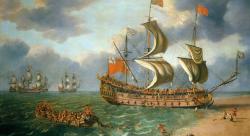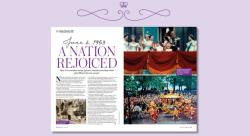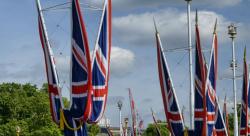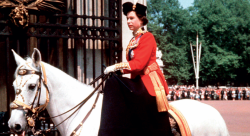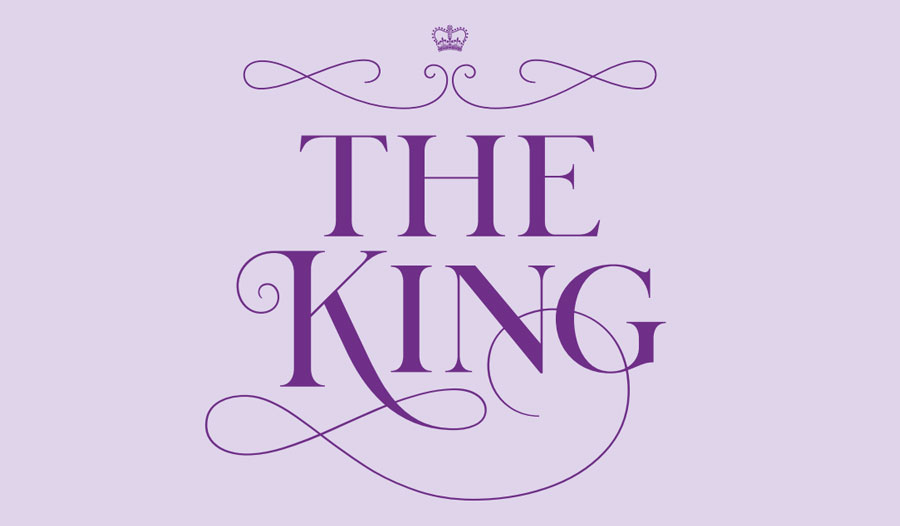
At once there was relief: the King spoke with authority, with dignity, and with no hint of mawkishness. First and foremost, as was right, he paid tribute to his mother, on behalf of the nation, and his family. Only then did he sound a note of continuity, as he too vowed to serve with love and devotion. It was exactly as it should have been, superbly judged to embody what the monarchy is in the life of this country – at once personal and disembodied. Since then the King and Queen Consort have carried on quietly, not in a hurry. Following a Queen as loved and enduring as Elizabeth II, it would have been a huge mistake to rush through innovations or try to upstage their predecessor. Yet change there will be. Now is the time to look to the future and search the past for clues as to what it might hold.
Charles was born at 9.14pm on 14 November 1948 at Buckingham Palace. It had been a long labour and his father passed the time impatiently whacking balls in the palace squash court. In Trafalgar Square the fountains were lit blue in honour of a royal boy. Thus the prince’s royal life began. Within days he was displayed in his cot in the palace ballroom as members of staff filed past. By the age of three he had acquired a certain royal manner: ‘Where is the princess?’ he enquired on coming in from the palace garden. He meant his mother. Upon being told she was out, he said: ‘But why? She knew I was coming back.’ Another time, he instructed Mr Pollard, a chauffeur, to switch off the radio. ‘I don’t like Mrs Dale’s Diary,’ he said.
In the normal upper-class way, he spent much of his time with his nanny, Mabel Anderson, who was kind and understanding, though his parents were with him often. His father would read Longfellow’s poem The Song of Hiawatha to him at bedtime and, on one memorable occasion his mother appeared in her crown as she practised for her Coronation.
In 1953, the Queen gave him his Christmas presents early – mud-pie moulds and a glider – because she was going away on the Coronation tour, which would last six months. She managed to control herself while saying goodbye, but broke down in the corridor outside the nursery.
Fortunately, Charles’s adored grandmother, the Queen Mother, was on hand during his mother’s prolonged absence. He and Princess Anne had a wonderful time visiting a farm at Windsor, where he told a bemused attendant that ‘Mummy has promised us a baby’.
In the immediate aftermath of the Second World War the ‘stiff upper lip’ was not simply a mannerism but the only hope of emotional survival. The Queen and the Duke of Edinburgh were concerned that their son should not be spoiled: ‘Dog leads cost money,’ his mother told him once when he lost one. He had to go back and look for it.
When he first went to prep school at Cheam he suffered from an upset stomach on account of the rich food, which he wasn’t used to. Nevertheless, his nanny noted that he seemed unusually sensitive and at times shy and uncertain.
The Queen and the Duke of Edinburgh can hardly be blamed for being more than usually concerned with their son’s upbringing, since he was heir to the throne. His lack of confidence troubled them, although it wasn’t the only reason they took the bold decision to send him to school – they wanted him to have a childhood like everybody else’s.
Charles is the first king of this country to have gone to school. This is possibly, in the words of Wesley Kerr, the veteran royal broadcaster, ‘the most significant thing about him’. Much has been made of his unhappiness at boarding school, especially at Gordonstoun, and the Duke of Edinburgh is routinely blamed for failing to see that this ‘macho’ outdoor school might not suit his thoughtful, retiring son as it had suited him.
No doubt he would have thrived better at another school, but the vmain problem seems to have been a combination of Charles’s innate lack of affinity with other children (he has always preferred the company of older people) and his princely position – he would always be ‘different’.
At the age of 17 he escaped the rigours of Gordonstoun when he spent six months at Timbertop, the outback branch of Geelong Grammar School in Melbourne. In Australia nobody cared who he was. Suddenly he was thriving, undertaking what sound like never-ending ‘bush-tucker trials’ with enthusiasm and blossoming as his own brand of compassionate leader. Back at Gordonstoun, on the strength of his Australian experience, he became head boy.
Charles’s education continued at Cambridge, and then in the Royal Navy, with further excursions into the other services. It’s striking how his programme was contrived by others – namely his father and the royal advisers – and how much he was alone, especially when he was studying Welsh at Aberystwyth, stuck in a little grey ‘cell’, as he put it. He was very much out of step with the typical students of those days, who he described as ‘long-haired, bare-footed and perspiring’.
But what would Buckingham Palace have done if he had turned into one of them? His position isolated him. Almost inevitably his educational experiences were contrived to some extent, and ultimately his future was laid down for him. Often he was absent, carrying out royal engagements. How could he ever truly join in?
There was lack of freedom and loneliness, with constant new challenges thrown in – Cambridge, then Aberystwyth, then Cambridge again, then the Navy, with spells in the RAF. Many young men just wouldn’t have survived. But Charles did.
It was a long education, only ending in 1976 when Charles left the Navy at the age of 28. Prince Philip may not have envisaged that his son would acquire ‘backbone’ in quite the way he did, but the twin strands that would shape the life of the Prince of Wales were in place.
As those of us who are products of boarding school will know, the experience is simultaneously damaging and bracing. Charles acquired an instinct for survival which was going to be much needed in the years that lay ahead. But he also had acquired distinctive interests and an outlook that school and university had given him. He had a proper degree, which included, at his own insistence and against advice, studying archaeology and anthropology. He was tending towards the arts; he loved music; he was fascinated by the enduring qualities of so-called ‘primitive’ societies and how they were being eroded by modern technology. He was much more his own person than many a monarch-in-waiting before him.
Self-evidently, Charles’s time as heir to the throne would be prolonged. His mother was 22 when he was born and 26 when she became Queen. His first striking move was to use his severance pay from the Navy to start The Prince’s Trust. Inspired by his own difficult and isolated early life as an outsider, he set out to help young people from disadvantaged backgrounds by providing opportunities for them to build their confidence and become independent. The palace was nervous that his project might fail or attract political controversy, but Charles was determined.
As we all now know, The Prince’s Trust was and is a roaring success. By the 1980s it was raising more than £1 million a year. Over nearly 50 years it has helped young people get a start in business or develop skills. The enterprise, direct and practical, was completely different from anything his mother would ever attempt.
In his first memorable broadcast as King, Charles mentioned the charities and causes ‘I care about so deeply’. Intellectual snobs have sneered at his ‘pretensions’, but nobody could doubt his sincerity and passion. He was determined to use the influence afforded by his position to make the world a better place. At times such idealism can go too far, or lead a person into a morbid kind of frustrated paralysis. Publicity for his initiatives was not always good, and the Queen and her advisers were frequently alarmed by his outspoken attacks on conventional medicine or genetically modified crops. He was even dismissed as a crank who ‘talked to plants’.
Charles was more of a rebel than he might appear. In the 1970s he made a point of conspicuously windsurfing in front of the Royal Yacht Squadron in Cowes because he knew it would upset the old buffers there who disapproved of the new-fangled sport. This was a rare of example of him embracing innovation. On the whole his rebellion has been in a backwards direction. Most famously he attacked modern architecture. His talent for acting, discovered at school, when translated into public speaking and television appearances was a great help in this respect. He became an effective and impressive communicator.
James Lees-Milne, the architectural scholar and adviser to the National Trust, watched Charles’s 1988 broadcast about the horrors of tower blocks with Gervase Jackson-Stops, another renowned expert in the field. ‘He spoke well and confidently, never tripping up,’ Lees-Milne wrote in his diary. ‘I agreed with every word, as did Gervase.’ Previously, after a private conversation with Charles on the same subject, Lees-Milne had said he was ‘well-meaning but ignorant’ – but no longer perhaps.
It was in May 1984 that Charles dropped his bombshell in a speech to the Royal Institute of British Architects at Hampton Court. He launched a devastating attack on the vanity and self-regard of modern architects in general and two projects in particular – the proposed National Gallery extension and a planned City of London skyscraper by Mies van der Rohe, which he condemned as a ‘glass stump’.
He put his criticism into practice by building, at Poundbury in Dorset, a model town constructed on a more familiar human scale, in a vernacular style using traditional material and decorative features. There have been similar building projects all over his Duchy of Cornwall estate.
Neither of the buildings Charles had criticised got built. Maybe he had more power than he realised. But in the medium term the architectural profession was disgruntled, complaining of his excessive influence.
Alongside active campaigning, Charles got out and about just like the other members of the royal family. He gets insufficient credit for just how well he manages encounters with the public – breezy, approachable and unstuffy. There have never been any gaffes. ‘Snap!’ he said to the writer Francis King when he noticed they were wearing the same shoes. My grandmother’s friend, Annette Bowen, gave him short shrift when he asked if the Girl Guides had been waiting long. ‘What do you think, Sir?’ she replied. He took it in good part. Another time, a young couple said they were keeping their fingers crossed for a baby. Charles explained jovially that babies are not made by just doing that.
Quietly, he has tried to move the monarchy into more informal territory. But other events, namely the breakdown of his marriage to Princess Diana, always seemed to drain attention in the wrong direction. There is much to regret. Recriminatory attacks are never a good idea, as certain younger members of the royal family will no doubt find out in due course. But the furnace of opprobrium from which Charles emerged was very much of his own making. Once again, he survived, as lesser men would not have done. Rarely mentioned is the supreme irony that Queen Camilla, of all the new recruits to a family that has had difficulties with daughters-in-law, to say the least, has proved such a wonderful asset to the monarchy.
At one time she was one of the most the reviled women in the United Kingdom. Charles showed great persistence and skill in coaxing the public round to her, in the process bringing the monarchy up to date in the matter of family relations. But Camilla herself must surely take much of the credit as well. She is immensely likeable, decent, doesn’t complain and brings just the right note of informality to royal engagements.
On an early visit to St Albans Abbey she spied a ladder and made to climb up it. ‘Not in those shoes,’ her lady companion instructed. Then there was a tea party for children suffering from cancer at Clarence House in December 2003. The Duchy Originals biscuits she offered were not liked. ‘Is it disgusting?’ she said to one child. ‘Why don’t you put it back?’ Touring Egypt in 2006 she established friendly relations with the accompanying press pack: ‘What’s your hotel like?’ she asked of one. ‘Pretty horrible,’ was the reply. ‘Well, ours hasn’t got any electricity,’ she shot back consolingly.
The King and Queen have been married for 18 years now. It has been a calmer time, with Charles eschewing public controversy as he prepared for his accession. Besides, so many of his ‘causes’ have become mainstream. The weirdo, fuddy-duddy prince turns out to have been ahead of his time – notably of course on climate change and the environment, where he is even acknowledged as something of an expert, but also on heritage and conservation and even, to some extent, on alternative medicine. The particulars may be open to dispute, but the broad sweep of his concerns is now almost universally accepted.
Even the humblest new housing project attempts to blend in with existing buildings, uses traditional materials appropriate to the locality and is conceived on a human scale. No more brutal tower blocks dumped down on a bit of waste ground.
As King, as Charles acknowledged in that first historic broadcast after his mother’s death, he must step back from campaigning charity work. But surely his particular style of informed and practical involvement will continue in some shape or form? What we saw that day, without realising it perhaps, was Charles transforming into a King before our eyes, albeit one who referred to his ‘darling wife’ and spoke of his love for his son, Harry, in a personal way that was already a departure from previous reigns.
The immediate appointment of William as Prince of Wales was significant. Coming to the throne at the age of 73, the King will hope for the substantial involvement of his heir in a reign that might not be long. It would be fanciful to call Charles a ‘philosopher king’, but our new monarch is very different to his predecessors. He reads books, and his compassion is informed by knowledge. As heir-in-waiting, he was remarkable: not waiting but doing, and achieving so much.
His engagements as King in the interim period before the Coronation have put a notable emphasis on inclusion, volunteering and community projects – much more specific already, not just the generalised royal presence. But the Coronation itself, on 6 May at Westminster Abbey, will mark the real beginning of his life as sovereign. His Majesty King Charles III will meet new challenges, but all the signs are that he will meet them well. He has the makings of a great King.



